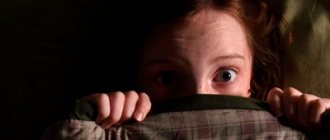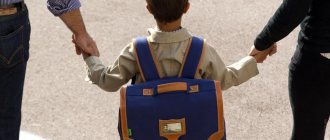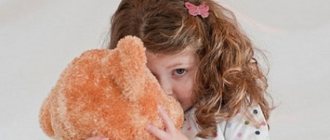A child's education in an educational institution affects not only his intellectual, but also his psychological development in a broader sense. An important component of the latter is the emotional development of the child. Arriving at school, in addition to joy, surprise, and self-confidence, the child also experiences grief, anger, uncertainty, and fear. Full, comprehensive development of the child’s emotional sphere, especially in the primary grades, is a necessary condition for preserving the student’s psychological health. Such development is possible subject to timely and accurate diagnosis of the child’s emotional development from the very first day of school.
The purpose of our research is the school fears of primary school students.
Fear - anxiety - worry - phobia
In various psychological theories, fear is attributed to different classes of emotional phenomena: feelings (E. Claparède, P.M. Jacobson); to affect (M. Wilson); to stress (R. Ellins); to mental states (N.I. Konyukhov, A.T. Zlobin); in addition, it is considered as an acquired motivation (J. Nutten), as a mental ability, i.e., as a function of reflection (V.K. Vilyunas, E.D. Chomskaya), as a trigger for the instinct of self-preservation (M.V. Osorina , N.I. Reinwald, etc.). In numerous definitions of fear, the following essential features can be identified:
- fear is of an affective nature;
- fear involves the experience of real or imagined danger;
- fear is classified as a negative state (E. Claparède, A.R. Luria).
In our work we will adhere to the definition of fear given by A.I. Zakharov: fear is an affective (emotionally acute) reflection in the consciousness of a specific threat to human life and well-being
. Fear is protective.
There are many bases for classifying the state of fear: by the subject of the experience, by the object, the intensity of the experience, by the origin, the nature of the course, by the types and methods of occurrence, by the strength of the experience (A.I. Zakharov, V.I. Garbuzov, V.K. Vilyunas), etc. Fear performs the following functions: protective, synthesizing, regulatory, signaling, evaluative, inhibitory, adaptive, organizing - disorganizing and heuristic (V.K. Vilyunas). There are also a number of author’s points of view on the classification of fears (S. Freud and others).
To determine the subject of research, it is necessary to consider a group of concepts related to the concept of “fear”: anxiety, fear, anxiety, phobia. Anxiety
- the experience of emotional discomfort associated with the expectation of trouble, the premonition of impending danger.
Unlike fear as a reaction to a specific real danger, anxiety is the experience of an uncertain, diffuse, non-objective threat. Fear
is a stable state of fear.
To study school fear, it is important to consider the relationship between the phenomena: fear - anxiety - anxiety - phobia. Fear arises as a reaction to a threat, and this threat must be specific. Anxiety, unlike fear, is not always a negatively perceived feeling, since it is also possible in the form of joyful excitement and exciting expectations. The unifying principle for fear and anxiety is the feeling of uneasiness. In turn, fear can be considered as an expression of anxiety in a specific, objectified form, if the feelings are not proportional to the danger and the anxiety takes a protracted course.
In the process when fear becomes part of a person's character, anxiety appears. Anxiety
- an individual psychological feature that manifests itself in a person’s tendency to experience frequent and intense anxiety and a low threshold for its occurrence. It is considered as a personal formation and/or as a property of temperament, due to the weakness of nervous processes.
Phobia
- an obsessive state of fear. Often in the psychological literature, the concepts of “fear” and “phobia” are considered synonymous with respect to mental phenomena. This trend can be seen especially clearly in foreign literature. School fears of students fall into the field of study by psychologists, psychiatrists, and psychoanalysts most often when it comes to a painful, obsessive state of fear, i.e., phobias. A.I. Zakharov identifies school phobia as an obsessively pursued fear of going to school.
In our research, we would like to dwell on the problem of studying school fears
, i.e. fears associated with school. These fears should be studied by educational psychology in order to make certain adjustments to the educational process of an educational institution.
When a child enters school, his social status changes. This leads to a reorientation of the child to social norms and attitudes. According to various authors (N.I. Gutkin, O.V. Khukhlaev, etc.), a child who is ready to study at school does not experience fear of it. A first grader happily enters the classroom, ready to communicate with the teacher, fulfill his requirements, learn something new, and obey the requirements imposed by the school.
A.I. Zakharov, based on observations, came to the conclusion that if fear arises at primary school age, then most often it is the fear of not meeting the social requirements of the immediate environment, be it school, peers or family. “This is expressed in fears of doing something wrong, not right, not as one should, as one should, not being someone who is respected. This speaks of growing social activity, of a strengthening sense of responsibility, duty, obligation, i.e., of what is united by the concept of “conscience” as a central new formation of primary school age” [2, p. 63].
Finding a child in a group of peers with whom he is connected not only by personal but also social relationships (classmates) can contribute to both the emergence of school fears (for example, the fear of being worse than others) and help to overcome some school fears (for example, “everyone has done everything”). , and I can do it”).
I would especially like to highlight the fear of grades (fear of getting a bad grade). On the one hand, this fear negatively affects the development of the student’s cognitive activity and his attitude towards the subject being studied. On the other hand, fear of grades in modern schools is often the leading motive for learning. There is a possibility that overcoming it without creating a more acceptable learning (educational) motive may have a negative impact on the learning process. It is necessary to resolve this contradiction when creating psychological and pedagogical conditions for overcoming school fears.
There are fears, a reason
which
is not directly related to the school, but has a negative impact on the learning process
. For example, the fear of leaving home or separation from parents is caused by anxious attachments within the family; it prevents the student from mastering a new social status. This group of fears is not included in the field of study of educational psychology, since most often it indicates the child’s unpreparedness for schooling and should be the subject of study by developmental and clinical psychologists.
Thus, based on the analysis of psychological and pedagogical literature, we found that the description of the phenomenon of school fears in the primary grades was obtained mainly through observation and analysis of the general principles of the child’s psychological development.
The origin of fears in preschoolers
For various reasons, preschool children become the most susceptible to adverse factors. The number of children with signs of emotional distress is increasing. They become excitable, anxious or aggressive.
The origin of fears can be different. Some of them are observed due to problems and difficulties in the preschooler’s relationship with his parents or with peers. Others may be related to personal experiences. Psychologists believe that the formation of phobic disorders has 2 main theories of origin, which unite all the causes of occurrence.
The first theory is a traumatic factor, the second is a consequence of the threat of repetition of this factor. The characteristics of the mental development of children depend on the reality of the threat after experiencing stressful situations, which resulted in the formation of a fear of a certain stimulus. Affectively heightened perception of danger is part of the defense mechanism. Those children who suffer from fears change their own behavior and react differently emotionally.
Immunity to fears, that is, the absence of an impact on the psyche, is observed very rarely. Psychologists are sure that this is unnatural for the normal development of children. Such problems may indicate problems with expressing emotions, excessive excitability, and even weak self-preservation instincts.
Methodological support for studying school fears
In connection with the need for objective research, the problem of choosing methods for the psychological study of school fears arises.
Despite the fact that the problem of school fears is relevant specifically for elementary schools, in mass psychological and pedagogical practice, school fears are usually proposed to be studied using a small set of methods: the Philips School Anxiety Test, Zakharov’s “Draw Your Fear” projective technique, the Temple-Dorkey Childhood Anxiety Test and some others that are not widely used in school practice.
The Philips School Anxiety Test is the most common in school practice. Initially, this test was intended for children of early adolescence, but in the last decade it began to be actively used in school practice and for primary school age. The purpose of the methodology (questionnaire) is to study the level and nature of anxiety associated with school in children of primary and secondary school age. The test consists of 58 questions that can be read to students or given in writing. Each question requires a clear answer “yes” or “no”. All content questions are combined into 8 factors.
Content characteristics of each syndrome ( factor
):
- General anxiety at school
is the general emotional state of a child associated with various forms of his inclusion in school life. - Experiences of social stress
are the emotional state of a child, against the background of which his social contacts develop (primarily with peers). In the spirit of our topic, this factor can be described as fear of classmates. - Frustration of the need to achieve success
is an unfavorable mental background that does not allow the child to develop his needs for success, achieving high results, etc. - Fear of self-expression
is negative emotional experiences of situations associated with the need to self-disclose, present oneself to others, and demonstrate one’s capabilities. - Fear of a situation of testing knowledge
- a negative attitude and the experience of anxiety in situations of testing (especially public) knowledge, achievements, and opportunities. - Fear of not meeting the expectations of others
- focus on the importance of others in assessing one's results, actions and thoughts, anxiety about the assessments given by others, expectation of negative assessments. - Low physiological resistance to stress
is a characteristic of the psychophysiological organization that reduces a child’s adaptability to stressful situations and increases the likelihood of an inadequate, destructive response to a disturbing environmental factor. In our topic, this factor can be designated as a manifestation of fear at the physiological level. - Problems and fears in relationships with teachers
are a general negative emotional background of relationships with adults at school, reducing the success of a child’s education.
For first and second grades, the following difficulties arise in applying this test:
- a large volume of questions does not allow you to conduct the test in one go, as required by the instructions;
- the desire of a first-grader to “be no worse than others” reduces the level of sincerity of answers;
- a low level of development of reflection of one’s mental functions reduces the effectiveness of survey methods at this age.
In psychological practice, the Philips test is used when examining third grade students. However, when we tried to conduct this test with third-grade students of a comprehensive school, in more than half of the cases difficulties arose in the children’s understanding of the wording of the questions, so the test became impossible.
In order to verify the adequacy of using the Philips school anxiety test to study school fears, we conducted a study of school fears among fourth-grade students at a Moscow gymnasium.
The researcher had two goals:
- Practically oriented goal:
study of the leading perceived school fears among fourth grade students. - Theoretical goal
: checking the adequacy of the method for studying school fears at the primary stage of education.
Common types of fears in children
Zakharov’s theories about the peculiarities of the formation of phobic disorders in children are still used by specialists today. According to his classification, preschoolers are classified with 12 to 15 different types of fear. The most common ones are:
- fear of parental death;
- fear of strangers;
- fear of the dark;
- night terrors;
- fear of water, fire or heights;
- fears of cats, dogs or other animals.
No less common are fear of parents, fear of being punished, or fear of doctors and injections. There are many options. A qualified specialist, when starting to correct the fears of preschool children, is obliged to study the clinical picture of the patient.
Night terrors in children
The work involves the use of special techniques, the objectives of which are based on creating a trusting relationship with the patient with inherent emotional contact.
To identify fears, it is important to use a ready-made, proven diagnostic model using special questionnaires or games.
Method
The study involved 72 fourth-grade students at a Moscow gymnasium (35 girls, 37 boys). The study was conducted in November 2005 in the middle of the school day in a quiet environment.
The procedure for administering the school anxiety test was quite standard. The test was administered in groups of no more than 15 people, in writing by a school psychologist with whom the respondents had a friendly relationship. The survey was carried out during school hours.
Identifying an anxious child in a group
Work with preschoolers can also be carried out in group classes. One of the ways to identify anxious children is to determine signs of fear according to the system created by G. Lavrentieva and T. Titarenko. The questionnaire includes 20 main points, each of which requires specific supervision of a specialist over children.
The specialist assesses whether a particular preschooler can:
- Play without getting tired.
- Complain when he has nightmares.
- Be subject to frequent mood changes.
- Have problems with appetite.
- Hold back tears during conflicts.
- Have problems sleeping.
To indicate the answers to the points, a table is built with the names of the children. The specialist puts a “plus” or “minus” next to each question. The total number of characters in the column of each test taker is counted. The level of anxiety determines the number of “+”:
- 1-6 – low;
- 7-14 – average;
- 15-20 – high.
This technique is ineffective for individual diagnosis. Its task is to identify anxious children, and not to find out the specifics of their fears.










